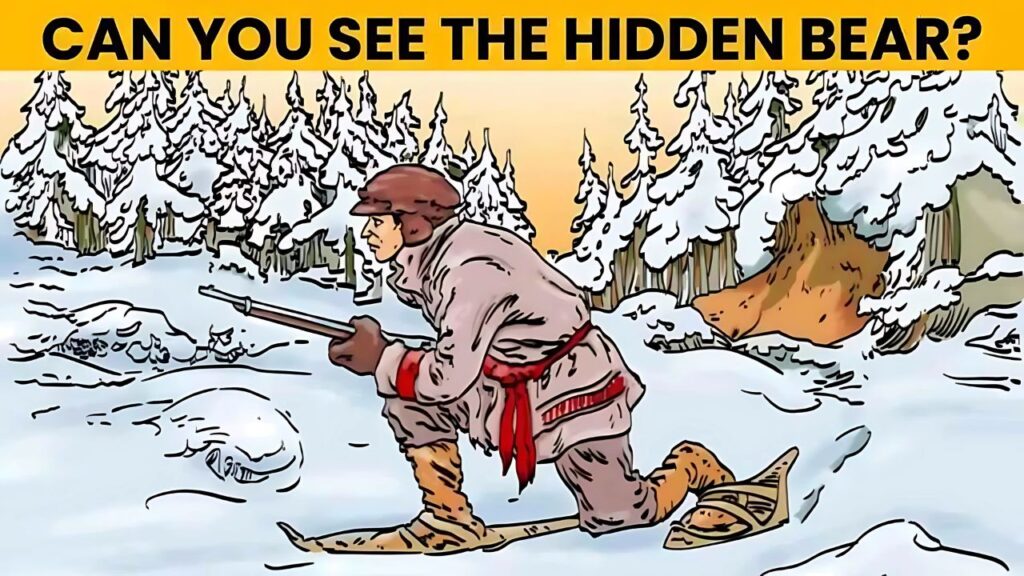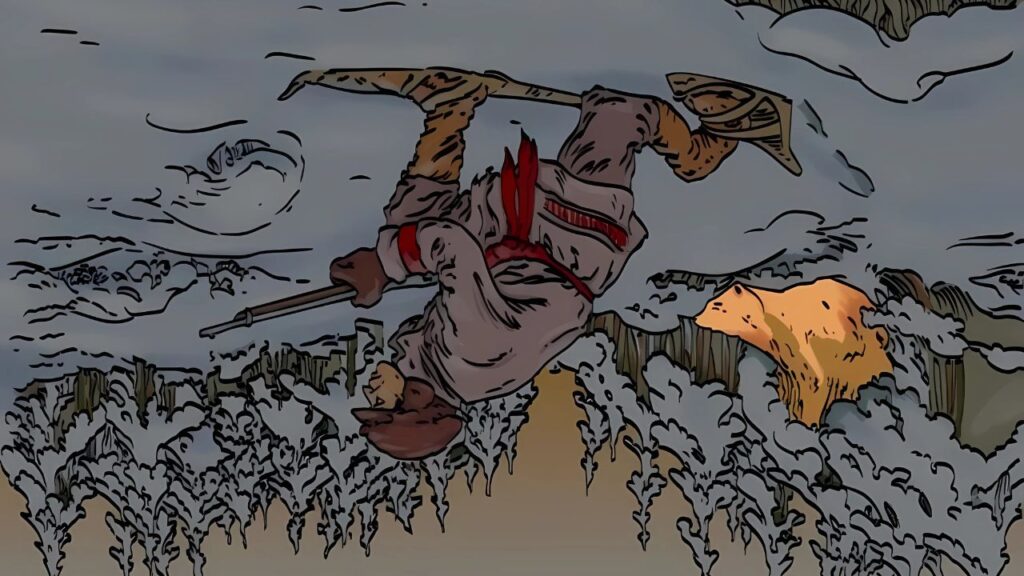Have you ever wondered how quickly your brain processes visual information? The answer might surprise you. Our minds work in fascinating ways when interpreting what our eyes see, sometimes playing tricks that reveal our cognitive processing speed.
In the lush wilderness of Australia, nature creates its own camouflage masterpieces. Animals blend seamlessly into their surroundings, making them nearly impossible to detect.
Today’s challenge comes from such a setting. A cleverly disguised bear hides within an Indian landscape image, testing not just your eyesight but your brain’s processing abilities.

Why Optical Illusions Challenge Our Minds
Optical illusions aren’t just entertaining puzzles. They reveal fundamental aspects of how our visual system operates.
When we look at an image, our brain doesn’t simply record what’s there. Instead, it actively interprets visual information based on past experiences and expectations.
This processing happens lightning-fast, usually without conscious thought. Yet some images deliberately trick this system, forcing our minds to work harder.
Scientists have discovered that people who solve visual puzzles quickly often possess superior pattern recognition abilities. These skills correlate with certain aspects of intelligence.
The speed at which you can identify hidden objects may indicate how efficiently your brain processes complex visual information. This efficiency forms one component of what we consider “intelligence.”
The Science Behind Visual Processing
Our eyes capture images, but it’s our brain’s occipital lobe that makes sense of what we see. This remarkable organ processes millions of visual inputs simultaneously.
When looking at complex images, your brain must filter relevant details from background noise. This filtering process requires significant neural resources.
Some people naturally excel at this visual discrimination. Their brains quickly separate meaningful patterns from distractions, allowing them to spot hidden objects faster than others.
This ability doesn’t necessarily reflect overall intelligence. However, it does demonstrate specialized neural pathways that process visual information with remarkable efficiency.
Research suggests that regular practice with optical illusions may actually strengthen these neural connections. Much like exercising muscles, challenging your visual perception might improve performance over time.
The Indian Wilderness Challenge
This particular illusion features a scene from the Indian wilderness. Dense vegetation creates the perfect hiding spot for our elusive bear.
Most viewers require at least 15 seconds to locate the animal. If you can spot it in just 8 seconds or less, you may possess above-average visual processing abilities.
Take a moment now to examine the image carefully. The bear is there, cleverly concealed among natural elements that match its coloration and shape.
Don’t be discouraged if you don’t see it immediately. Visual puzzles challenge even the sharpest minds, and persistence often leads to success.
Tips for Spotting Hidden Objects
When tackling optical illusions, several strategies can improve your success rate. First, try scanning systematically rather than randomly searching the image.
Let your eyes move methodically across the picture, section by section. This prevents overlooking areas where the hidden object might reside.
Another effective technique involves slightly unfocusing your vision. This sometimes reveals patterns that remain invisible when looking too intently at details.
Try viewing the image from different angles or distances. Sometimes a slight shift in perspective makes the hidden element suddenly appear obvious.
Remember that the brain processes shapes and patterns differently depending on context. What looks like natural terrain might transform into an animal’s outline when viewed with the right mental framework.
What Your Performance Reveals
If you successfully located the bear within 8 seconds, congratulations! Your visual processing skills rank among the top performers.
Finding the hidden image quickly suggests exceptional neural efficiency in your visual cortex. Your brain rapidly distinguishes subtle patterns that elude most observers.
Those who take longer shouldn’t feel discouraged. Visual processing represents just one of many cognitive abilities that contribute to overall intelligence.
Some individuals excel at numerical reasoning while others demonstrate superior verbal skills. Visual pattern recognition constitutes merely one facet of our complex cognitive makeup.
The most important benefit from these challenges comes from exercising your brain. Each attempt strengthens neural pathways regardless of how quickly you solve the puzzle.
Training Your Visual Intelligence
Like any skill, visual perception improves with practice. Regular engagement with optical illusions can enhance your ability to detect camouflaged objects.
Start with simpler challenges and gradually progress to more difficult ones. This incremental approach builds your pattern recognition capabilities over time.
Varied practice yields the best results. Expose yourself to different types of visual puzzles, from hidden objects to ambiguous figures and geometric illusions.
The human brain demonstrates remarkable neuroplasticity throughout life. Even adults can significantly improve their visual processing speed with consistent practice.
Consider incorporating these entertaining challenges into your daily routine. Just a few minutes each day might yield noticeable improvements in your visual acuity.
The Answer Revealed

Still searching for our elusive bear? Look toward the center-right portion of the image, where the bear’s outline becomes visible among the foliage patterns.
The bear’s head faces left, with its distinctive ears and snout just barely distinguishable from the surrounding environment. Indian wildlife experts designed this particular image to test observational skills used in wilderness settings.
If you managed to spot the bear within 8 seconds, you demonstrated exceptional visual processing abilities that would serve you well in natural environments where detecting camouflaged animals quickly might be advantageous.
Don’t worry if you needed more time – the important thing is exercising your brain and enjoying the challenge these visual puzzles provide.
Beyond Entertainment: Real-World Applications
These seemingly simple puzzles connect to important real-world skills. Professions like medical diagnosis, security screening, and wildlife observation rely heavily on pattern recognition abilities.
Radiologists must detect subtle abnormalities in medical images. Security personnel identify potential threats in busy environments. Wildlife researchers spot camouflaged animals in complex natural settings.
The neural pathways you exercise when solving optical illusions overlap significantly with those required for these professional applications. Your brain doesn’t distinguish between finding a hidden bear in an image and identifying important visual cues in everyday life.
This explains why some organizations use visual puzzles during recruitment processes. The ability to quickly spot patterns amid visual noise translates to valuable workplace skills.
Creating Your Challenges
Inspired to test your friends and family? Creating your own hidden object challenges proves surprisingly easy with today’s technology.
Smartphone apps can blend objects into complex backgrounds. Online tools generate customized optical illusions based on your specifications.
Sharing these puzzles on social media often generates enthusiastic engagement. People naturally enjoy testing their perceptual abilities against others.
Remember that difficulty level varies tremendously between individuals. What seems obvious to you might completely elude someone else due to differences in visual processing.
These variations highlight the beautiful diversity of human cognition. We each perceive the world through slightly different mental frameworks, resulting in unique interpretations of identical visual input.
Optical illusions like this hidden bear challenge do more than entertain us. They provide fascinating glimpses into how our brains construct visual reality.
The next time you encounter a visual puzzle, appreciate the complex neural processes occurring as your mind attempts to solve it. Your brain performs extraordinary feats of pattern recognition with each visual challenge it faces.
Whether you spotted the bear in record time or needed a few extra moments, the cognitive exercise benefits your brain. Regular engagement with such challenges may even sharpen your overall perceptual abilities.
So keep challenging yourself with optical illusions – your brain will thank you for the stimulating workout!
Did you manage to find the hidden bear within 8 seconds? If so, you possess remarkable visual processing abilities that place you among the top performers on this challenging Indian wilderness optical illusion. Share your results and challenge your friends to beat your time!
